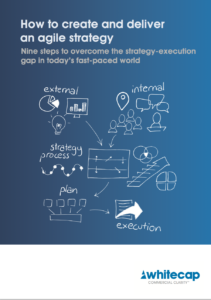 Richard Coates, Founder and Managing Director of Whitecap Consulting, shares his thoughts on developing and implementing a successful business strategy.
Richard Coates, Founder and Managing Director of Whitecap Consulting, shares his thoughts on developing and implementing a successful business strategy.
Research last year by accountancy giant PWC’s strategy arm, Strategy&, painted a picture of corporate leaders grappling with conflicting priorities, short-term targets and a culture of second-guessed decisions as they work to deliver their business strategies.
The survey of 3,000 board level people also found the biggest strategic challenges they faced were allocating resources and making day-to-day decisions in line with the strategy along with communicating the strategy and translating it into action.
 Our experiences mirror this research. All too often we see businesses not only struggle to develop an effective and focussed strategy, but also to then implement it across the entire business.
Our experiences mirror this research. All too often we see businesses not only struggle to develop an effective and focussed strategy, but also to then implement it across the entire business.
With that in mind, we’ve created a white paper, How to create and deliver an agile strategy. It features nine key steps for developing and implementing a business strategy and here is a summary of the key points.
Too many businesses describe their strategy in terms of “our target is to be a £100m turnover business” or similar in profit terms or valuation. Financial goals are not a substitute for strategy and leaders must look at external markets, identify customer needs and then focus on the actions that will deliver growth. Financial milestones should be used to measure the success of the strategy.
-
Have a common mental map of the strategy
If you ask everyone on your board to articulate your strategy, the likelihood is that everyone will have a different answer because they’ve all interpreted it to suit their own view. Make sure everyone understands the overall strategy for the business and what it means to them. Have regular checks to make sure each part of your business is working towards the common goal and come together periodically to check that all of the individual plans and initiatives all align together with the strategy.
-
Managing tension in the planning process
There is often tension between the growth ambitions of shareholders and the capacity of the company to deliver. By developing a clear strategy, you can quickly understand if your business has the skills and capacity to fulfil it. If not, consider allowing time for organic growth or consider acquisitions and partnerships to make your goals a reality. Help shareholders and members of the company to understand what needs to be done to deliver.
-
Is there a gap between vision and reality?
Senior managers often want to rush in and start delivering a new strategy without thinking out exactly what route they need to take to get there. Before embarking on a new strategy, break down the journey by creating a clear roadmap with milestones to achieve on the way. Work backwards from high-level goals and make sure everyone understands the journey as well as the destination.
-
Understand every personality
Strong leaders can have big personalities and their pursuit of a vision can often overlook the other personalities in their team, which can erode trust and leave many unsure of how they deliver that vision. Take time to understand each personality – tools like Myers Briggs are useful – and everyone’s personal drivers and motivations. Then work to make sure every personality can fit into the team, for example, using a tool such as Belbin.
-
Should I use an incremental or disruptive strategy?
Aiming for 5% year-on-year growth can be the right strategy, but have you just opted for more of the same rather than understanding how your market is growing and evolving? The internet has created global giants overnight and this has transformed the marketplace. Ask yourself if you understand all of the opportunities and check if any new players are using new tools to disrupt the market.
Balancing ambition against an achievable strategy is one of the biggest challenges leaders face. Make sure you have a sustainable and successful strategy by reviewing your performance, aims and external factors.
-
Rolling out a successful strategy
Once your board fully understands and can articulate the strategy, how do you ensure every part of the business can deliver? Avoid Chinese Whispers and make sure each part of the business has the skills and capacity to play their part. Involve two or three layers of management in developing the detailed part of the strategy and encourage them to stress test it and help refine it. Constant communication of long-term aims, decisions and performance is also key.
-
Managing glamour ‘pet’ projects
Just about every business will have a pet project that a CEO is convinced will transform the company. Sometimes they pay off, but they can be a major distraction and a drain on resources. A strategy must always be able to respond and flex to new opportunities and it’s helpful to have an objective checklist of criteria for investments and projects that fit the strategy. For any new project, put it up against the checklist and, if it fails, scrap it and stick to the strategy.
-
Avoiding strategy data overload
Facts and analysis are vital in strategy development, but by relying on swathes of data-driven and process heavy analysis, you can detach the strategy from senior management and the realities of your business’ capabilities. Strategy development must be owned by the CEO and senior management to ensure buy-in. While facts and figures are useful, it must be delivered and executed through the hearts and minds of everyone in the organisation.
These are our top tips based on our experiences. You can get more detail and real-life examples of how these can be implemented in your organisation in our How to create and deliver an agile strategy white paper.
